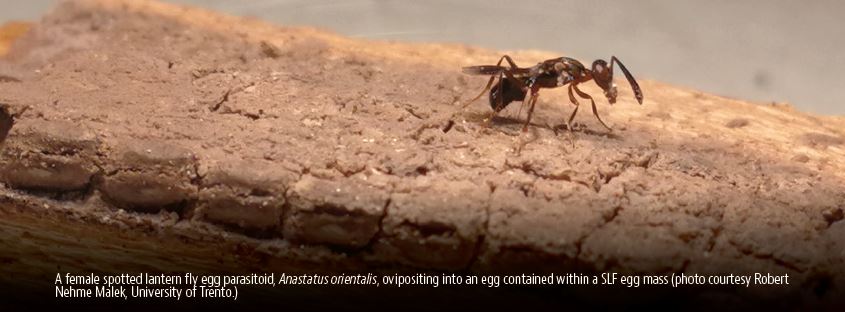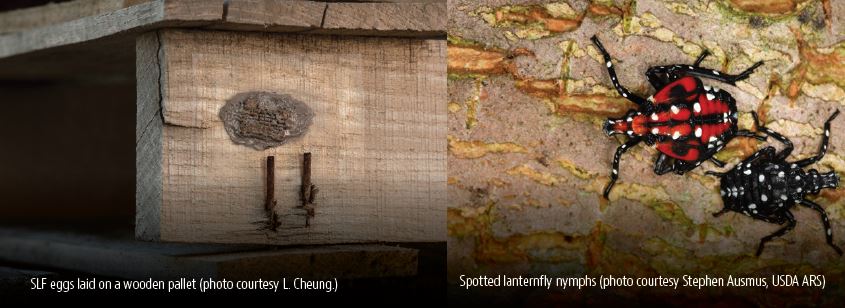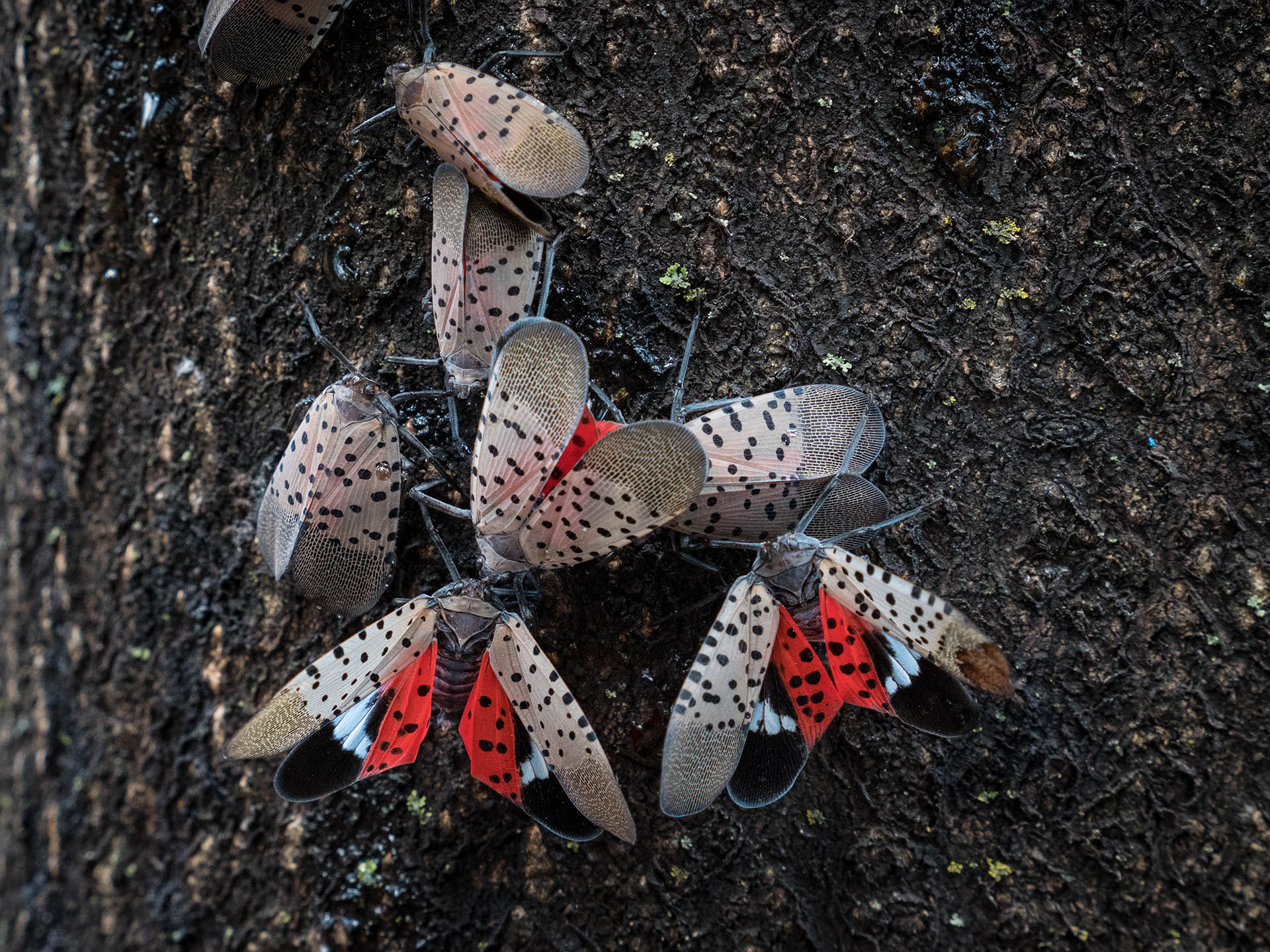The spotted lantern fly is joining the list of invasive insects that have the potential to impact California agricultural crops. This pest insect from China has not yet become established in California, but it has been known to arrive here as a hitchhiker on aircraft. Spotted lantern fly has become established in several east coast areas and has been proven a threat to apples, cherry and grape crops as well as hardwood trees. There is evidence in South Korea that it can attack walnut crops. University of California Riverside researcher Dr. Mark Hoddle said there is reason to believe SLF feeding has the potential to impact tree nut crops in California.
According to invasion biology specialists, the SLF is likely to make its way from the east coast to California.
Spotted lantern fly was first detected in the United States in Pennsylvania in 2014. Last year, California Department of Food and Agriculture inspectors looking for Japanese beetles in cargo planes reported that dead spotted lantern flies had been found at airports in Sacramento, Stockton and Ontario. It is believed they flew into the planes during loading activities in Allentown, PA. and died enroute.
A Proactive Approach
Hoddle said that rather than wait to see if SLF will become established in the west, proactive efforts in biological control have already begun. A goal of the CDFA’s Proactive IPM Solutions grant program is to anticipate which exotic pests are likely to arrive in California and to identify and test IPM strategies, including biological control, that can be rapidly implemented if the pests become established in California. CDFA is responsible for preventing and mitigating invasive pests in California. Techniques resulting from the Proactive IPM Solutions Program in advance of anticipated pest invasions will allow for rapid deployment of future management plans.
Funding for the three-year project to develop biological controls for SLF stems from the pest’s potential to economically impact high value specialty crops including almonds, walnuts and pistachios. Similar work is already underway on the east coast, Hoddle said. Biological controls for invasive species are favored over the adoption of intensive insecticide spray programs which may disrupt low-pesticide use integrated pest management programs.
Hoddle and Dr. Kent Daane at UC Berkeley are leading the project that involves testing an egg parasitoid as a biological control agent. One of the first parts of the project is to determine if the egg parasitoid, a small, stingless wasp also native to China, will pose an ecological threat- that is will it affect populations of beneficial insects and species native to the western US.
Interestingly, there are native lantern flies in Arizona that feed on juniper and oak trees. Hoddle said his research team has collected eggs from native lantern flies and native eggs are being exposed to the Chinese parasitoid to see if they will attack the eggs.
Completing this research before SLF hits, Hoddle said, will allow for rapid response if this pest becomes established in California and causes crop damage.

Spotted Lantern Fly Biology
Adult spotted lantern flies do have wings, but are not a type of fly or moth. Closely related to brown marmorated stink bug, aphids and leafhoppers, SLF is a planthopper in the order Hemiptera and is a true bug.
Dr. Surendra Dara, University of California Cooperative Extension advisor in San Luis Obispo County said there is no record of an established population of SLF in California, but this pest is known to be an efficient hitchhiker. Dara said the likely route for its arrival in California is in the form of egg masses on packages or vehicles. Adults may also hitchhike but they may not live long enough without plants to feed on to accidentally reach California.
Like all hemiptera, SLF have piercing-sucking mouthparts that enable them to drill into the phloem of a plant to feed on plant juices. As they feed, they also excrete honeydew, attracting ants and other insects. Honeydew promote sooty mold growth which reduces photosynthesis. Heavy feeding across a two-year period has apparently killed vineyards in Pennsylvania despite insecticide applications.
In Pennsylvania, SLF has one generation per year consisting of four nymphal stages, an adult stage and overwintering as egg masses. Spotted lanternflies molt to progress to the next stage.
SLF eggs hatch over an extended period of time with first instar nymphs emerging in May and June. Mating takes place late in the summer and eggs are laid throughout the fall, ending with the first freeze event.

First instar nymphs are a quarter of an inch in length and black with white spots. The second and third instars have the same coloration, but the fourth takes on a reddish color and is nearly an inch long when it becomes an adult. Adults have two sets of wings. The forewings are greyish brown. Hind wings are mainly red with black spots, a white band and black tip. The body of SLF is mainly black but the abdomen appears yellow with black bands. Though they have functioning wings, SLF jumps to move around more than it flies.
Spotted lantern fly has been documented to feed on more than 70 species of trees and plants. They can hitchhike on packages or vehicles, but are able to move three to four miles on their own. Egg masses, juveniles and adults can be found on trees and other plants as well as bricks, stone, metal or other smooth surfaces.
Signs of a SLF infestation can be detected by inspecting plants. This pest tends to gather in large groups at dusk and at night. One of their preferred hosts is the invasive tree of heaven. Egg masses laid on tree trunks or other surfaces can be camouflaged as the female SLF covers her eggs with a white putty-like substance that becomes pinkish gray as it dries. Weeks later, the covering will look like a patch of mud.
Biological controls for long term management of this invasive pest is preferred, Dara said, but pesticides are available for short term control or to knock down infestations.
Studies in Pennsylvania have found two naturally occurring fungal pathogens controlling SLF. One (Batkoa major) cannot be cultured and would be only a natural microbial control agent. Multiple commercial formulations of the other fungus (Beauveria bassiana) are available for use.
Dara said anyone encountering an SLF egg mass should contact their county agricultural commissioner’s office.
“We don’t want this pest to become established here. All it takes is one egg mass to go unnoticed,” Dara said.

Cecilia Parsons
Cecilia Parsons has lived in the Central Valley community of Ducor since 1976, covering agriculture for numerous agricultural publications over the years. She has found and nurtured many wonderful and helpful contacts in the ag community, including the UCCE advisors, allowing for news coverage that focuses on the basics of food production.
She is always on the search for new ag topics that can help growers and processors in the San Joaquin Valley improve their bottom line.
In her free time, Cecilia rides her horse, Holly in ranch versatility shows and raises registered Shetland sheep which she exhibits at county and state fairs during the summer.
















